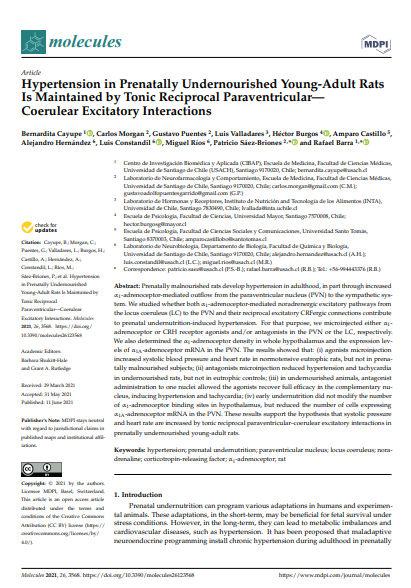Hypertension in Prenatally Undernourished Young-Adult Rats Is Maintained by Tonic Reciprocal Paraventricular-Coerulear Excitatory Interactions

Fecha
2021-07-05Autor
Cayupe, Bernardita
Morgan, Carlos
Puentes, Gustavo
Valladares, Luis
Castillo, Amparo
Hernández, Alejandro
Constandil, Luis
Ríos, Miguel
Sáez-Briones, Patricio
Barra, Rafael
Burgos, Hector [Univ Mayor, Fac Ciencias, Escuela Psicol, Chile]
Ubicación geográfica
Notas
HERRAMIENTAS
Acceda a títulos restringidos
¿Cómo descargar?Resumen
Prenatally malnourished rats develop hypertension in adulthood, in part through increased alpha(1)-adrenoceptor-mediated outflow from the paraventricular nucleus (PVN) to the sympathetic system. We studied whether both alpha(1)-adrenoceptor-mediated noradrenergic excitatory pathways from the locus coeruleus (LC) to the PVN and their reciprocal excitatory CRFergic connections contribute to prenatal undernutrition-induced hypertension. For that purpose, we microinjected either alpha(1)-adrenoceptor or CRH receptor agonists and/or antagonists in the PVN or the LC, respectively. We also determined the alpha(1)-adrenoceptor density in whole hypothalamus and the expression levels of alpha(1A)-adrenoceptor mRNA in the PVN. The results showed that: (i) agonists microinjection increased systolic blood pressure and heart rate in normotensive eutrophic rats, but not in prenatally malnourished subjects; (ii) antagonists microinjection reduced hypertension and tachycardia in undernourished rats, but not in eutrophic controls; (iii) in undernourished animals, antagonist administration to one nuclei allowed the agonists recover full efficacy in the complementary nucleus, inducing hypertension and tachycardia; (iv) early undernutrition did not modify the number of alpha(1)-adrenoceptor binding sites in hypothalamus, but reduced the number of cells expressing alpha(1A)-adrenoceptor mRNA in the PVN. These results support the hypothesis that systolic pressure and heart rate are increased by tonic reciprocal paraventricular-coerulear excitatory interactions in prenatally undernourished young-adult rats.
URI
https://repositorio.umayor.cl/xmlui/handle/sibum/9092https://www.ncbi.nlm.nih.gov/pmc/articles/PMC8230629/pdf/molecules-26-03568.pdf
https://doi.org/10.3390%2Fmolecules26123568
https://www.mdpi.com/1420-3049/26/12/3568/pdf?version=1623392242
Coleccion/es a la/s que pertenece:
Si usted es autor(a) de este documento y NO desea que su publicación tenga acceso público en este repositorio, por favor complete el formulario aquí.